 Ask a Question
Ask a Question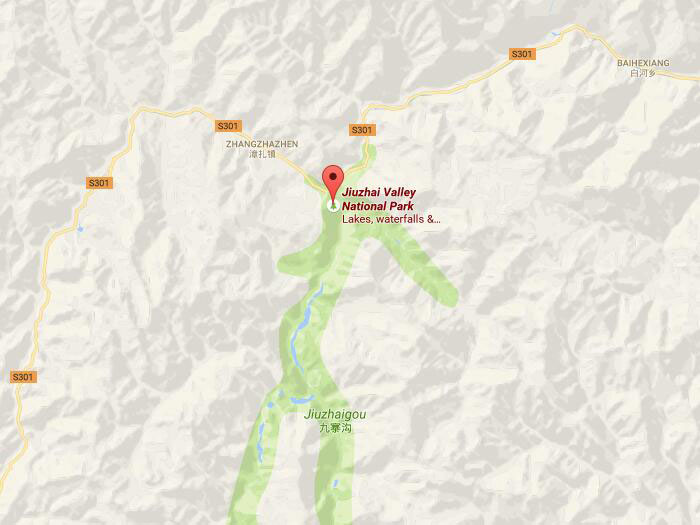

Zhangzha Town, Jiuzhaigou County, North of Sichuan Province, China
World Natural Heritage; National Nature Reserve; National Geological Park
Jiuzhaigou Valley is located in the Aba Tibetan Autonomous Prefecture, north of Sichuan Province in China. This land features perennially snow-capped mountain peaks, verdant and lush forest, stretches of serene lakes, and various birds and animals, all contributing to the unique view of Jiuzhaigou Valley. Upon entering the resort, you will find yourself strolling in a fairyland, leaving behind nothing but earthly troubles and vexations. It is a world of water. Water brings Jiuzhaigou Valley its most enchanting views, which is the soul of the place. Whether you are met with serene lakes or plunging waterfalls, you will enjoy yourself so much among the charming sights as to linger on with no thoughts for home.

The local people of Jiuzhaigou Valley call these lakes ‘Haizi', meaning little sea in Chinese. Jiuzhaigou Valley has a total of 108 “haizi” of varying sizes and shapes, but of invariant limpidity to the bottom of the lakes. Some of the lakes are hidden in the valleys, and others inlay the virgin forests. On sunny days, algae and sediments at the bottom of the lakes send out colorful lights. The lakes, thus, have gained another name call ‘Wuhua Hai', meaning ‘multicolored sea' in Chinese from the locals.
A beautiful local legend has it that a very long time ago, there lived a beautiful and kind-hearted goddess in the mountain east of the Jiuzhaigou Valley and an industrious and chivalrous god in the mountain west of the Jiuzhai Valley. As time went by, they fell in love with each other. One day the god presented a big and shiny divine mirror to the goddess as a token a love. The goddess reached out to take it, but she was too exited and nervous to hold fast the mirror. Hence, the mirror slipped from her trembling fingers and dropped to the valleys, breaking into 108 pieces. The 108 mirror pieces turned out to be 108 winkling and glittering crystal lakes of different sizes, covering the land of Jiuzhaigou Valley.
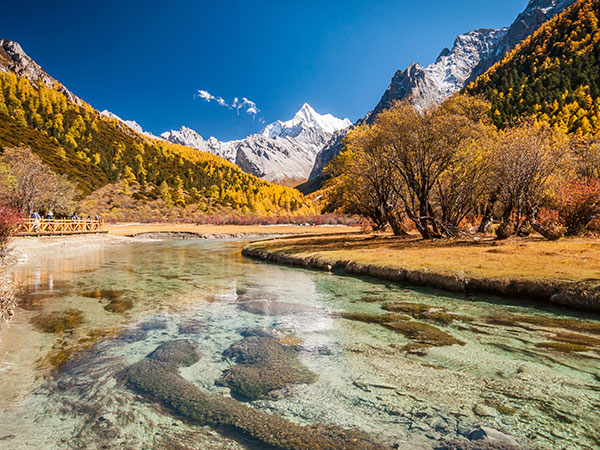
With an elevation of 2,000-3,000 meters above the sea level, the area enjoys a favorable climate that is cool in summer while immune from the cold wind of the winter season, presenting the beautiful scenery all year around. In spring the ice and snow begin to melt, and water and stream begin to flow and mountain flowers blossom. The soft and lazy spring sun kisses the surface of the lake and the spring shoots. The sight is really refreshing and touching. In summer, Jiuzhaigou Valley is overshadowed by green trees. And the silver waterfall expresses their most unrestrained feelings.
Autumn is the most splendid season in Jiuzhaigou Valley when colorful leaves and woods are reflected in the water and the fallen leaves are floating amidst the shinning waves of the lakes. The sky here is vast, clear and blue. The most beautiful scenery created by nature is right before your eyes. As winter comes, Jiuzhaigou Valley becomes quiet, serene and poetic. The mountains and forests are covered by snow, and the waterfall and lakes are crystal clear and jade-like. The ice on the blue lake surface shows wonderful and different lines as the temperature changes between sunrise the sunset.
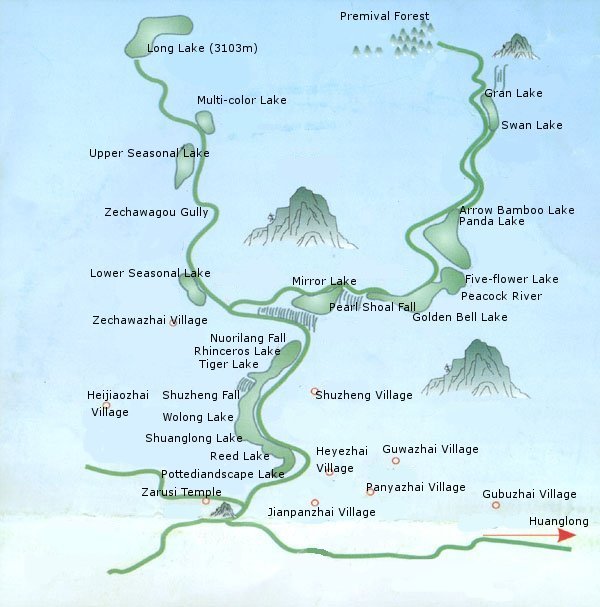
Rize Valley is the south-western branch of Jiuzhaigou, and it contains the largest variety of tourist sites in Jiuzhaigou Valley and is typically visited first. From the Nuorilang to virgin forests which is about 18km totally, visitors may be in a fantastic world all the time. Here are many colorful lakes like a kaleidoscope, like a fairyland tranquil and abstruse, and like a mystic mirror. It is usually suggested to visit downhill from its highest point by taking shuttle in the scenic area, then visitors will pass and the following sites one by one:
【Primeval Forest】
Primeval Forest is well-protected ancient woodland. It is about 2930 meters above sea level and covers an area of 54o hectares, where plantation mainly consists of huge fir trees and Spruce, and underbrush includes honeysuckle, cuckoo, arrow bamboos, etc. It is fronted by spectacular views of the surrounding mountains and cliffs, including the 500-metre-high, blade-shaped Sword Rock.
Primeval Forest in Jiuzhaigou Valley
【Sword Rock and Suspended Spring】
Sword Rock is an isolated peak with a height of more than 500 square meters, shaped like a sword stab into the blue sky. Walked down from the primeval forest people can see Jianyan Rock. The side that Sword Rock face to the Fangcao Sea, there is spring water pour out from the mountainside vertically, such as white silk hangs in the air, and falls down along the rocks. The height is more than one hundred and thirty meters, people called that the Suspension Spring, which is goodness Semo’s tear when she looked for god Dage, according to the legend.
【Fangcao Sea】
Fangcao Sea (fragrant grass sea) named after luxuriant fragrant grass above the sea surface. Here is quiet and peaceful, fragrant grasses reflect in the water, and sometimes there are water birds. If it is raining season, go sightseeing in the rain is also interesting.
【Swan Lake】
At an elevation of 2,905 meters Swan Lake is surrounded by high rocky cliffs that drop vertically into the lake. The lake takes is name from large numbers of migratory swans that visit it each year.
【Panda Lake】
Panda Lake has an average depth of 14 metres and as its name implies is in the heart of panda country. This area is surrounded by bamboo forests and a mix of deciduous and coniferous woodland. The vivid green color in autumn attracts tourist all over the world.
Panda waterfall height of 80 meters, the sea is famous for its high waterfall in Jiuzhaigou. Tourists from the trestle stand of Panda Lake north side come to an end and go slowly down along a steep downward ladder can see on the right side there is a crystal water from the pier, and rush out of the Panda Lake to the deep canyon. This torrent is cut into several segments by protruding cliff and rock, and several segments of waterfall join in together as the Panda Waterfall.
【Arrow Bamboo Lake】
Arrow bamboos are one of the favorite foods of Giant Pandas. There are large stretches of Arrow Bamboo growing around the lake, so it got its name as Arrow Bamboo Lake. Arrow Bamboo Lake covers an area of 170,000 m2, and is a shallow lake with a depth of 6 meters. It l was a main feature site for the 2002 Chinese film Hero.
Arrow Bamboo Lake in Jiuzhaigou Valley
【Panda Lake】
Panda Lake features curious color patterns of blue and green. Giant Pandas were said to have come to this lake to drink, though there have been no sightings for many years. The lake empties into the multi-stream, multi-level Panda Waterfalls, dropping 78 meters in three steps.
【Peacock Riverway】
From the trestle stand of water outlet of Five Flowers Sea to the hill road, along the downhill road, the left side of the ravine is the Peacock Riverway.
【Five Flowers Sea】
Five Flowers Sea with the reputation of "the Special Scenery of Jiuzhaigou" and "Jiuzhai Essence" is located at the end of the upstream of Peacock Riverway. Along the serene road, downhill all the way, through serene forest, you will find Five Flowers Sea soon. On the west side of the Five Flowers Sea, there is a plank road is an excellent point to appreciate the scenery. Visitors can stop here for a while. Along the road and head to north to the north shore of Five Flowers Sea for 100 meters and there is an opening and a gently hilly land. Here is the intersection of Five Flowers Sea water outlet and Peacock River, and over the river there is a trestle stand. In the south side of the trestle stand, the water surface is colorful, blackish green, sapphire blue, green and yellow colors mixed together, looks like colorful peacock wings; the north side of the trestle stand, the water is bended just like peacock’s head and neck, and three ancient trees there just like peacock feather on the top. Therefore, the following river is called Peacock Riverway.
Five Flowers Sea in Jiuzhaigou Valley
Going north around 100 meters along the left bank of the Peacock River, and cross the river way to the highway around the mountain. Overlooking the Five Flowers Sea from the highway, the scenery is more amazing. Going towards southeast along the highway, and you will reach its highest level in the south, there is a large stone, called the tiger stone. Standing on the tiger stone and looking down, the outline of the Five Flowers Sea can be observed. Five Flowers Sea is the most splendid scenery in Jiuzhaigou scenic spot. Nearby hillside, after autumn they are enveloped in beautiful autumn scenery with rich colors.
【Pearl Shoal and Pearl Shoal Waterfall】
Pearl Shoal and Pearl Shoal Falls are best viewed by taking the walkway. This takes visitors across the "Golden Bell Lake" and "Pearl Shoal" down the left side of the falls then across the base of the Falls to "Mirror Lake". Pearl Beach Waterfall is 200 meters wide, and the falling head are 40 meters, which is particularly spectacular. The waterfall rushes into the valley bottom, roars like thunder, and rolls up spindrift, and runs to the east. This stream is the most beautiful, most fierce, the loudest segment of Jiuzhaigou Valley. The plank road on the east of rapids is the best place to see the waterfall. The Peacock Riverway is wriggled; on both sides are the heterozygous flowers. Once autumn comes, the trees on either side are the dyeing cream color, autumn leaves are scattered full of the whole river. Looking down from a height, it is like a peacock to show its gorgeous tail.
Pearl Shoal Waterfall in Jiuzhaigou Valley
【Eagle Claw Cave】
Eagle Claw Cave is near the side of the road of the Swan Sea. Here was a story about a Tibetan hero Gezhaier. It was said that in Jiuzhaigou valley there used to have an evil devil that often deceived and squeezed the people, brought Jiuzhaigou all kinds of natural disasters. King Gezhaier determined to get rid of an evil for the people. They started a big fight in the Eagle Claw Cave, finally, King Gezhaier eliminated the devil.On the interior walls of the cave there are more than 50 pawprints, according to legend this is left by King Gezhaier when he fought and killed the devil.
【Mirror Lake】
Mirror Lake is so named because of its ability to reflect the images of the surrounding mountains and forests. The Lake was featured in the Zhang Yimou movie Hero. The outflow of "Mirror Lake" is through the "Rize Gully" a travertine ramp of small ponds and natural bonsai trees and bushes that lead directly to one of the great sights of Jiuzhai Valley.
Mirror Lake
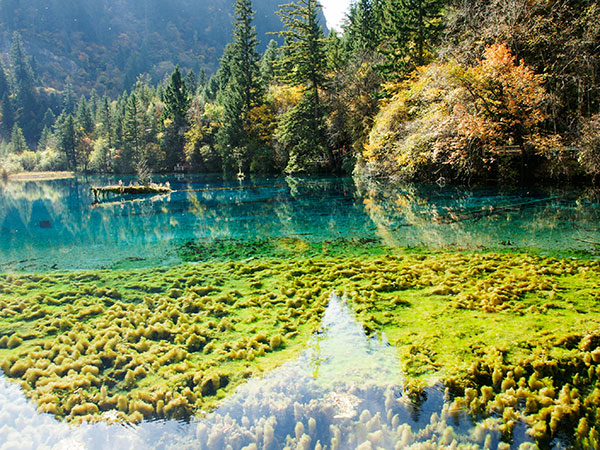
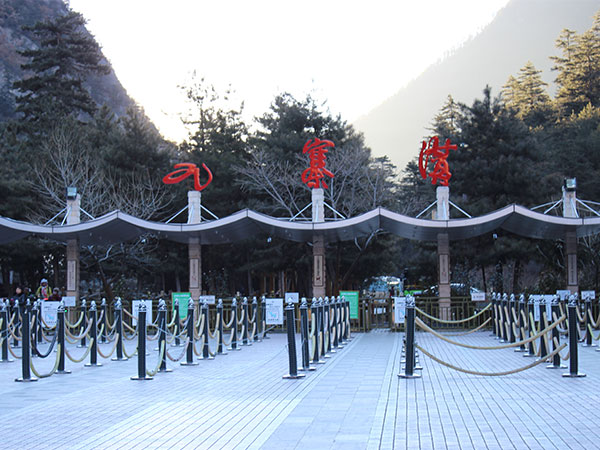
The best time to visit Jiuzhaigou is in the late Spring and the Autumn, especially in April, May, September and October. At this time, the water resource is very adequate, lots of waterfalls and brook here and there. Especially in September and October when the valley is decorated by colorful autumn leaves, Jiuzhaigou Valley is known as the fairyland of colors.
6 Days Chengdu to Jiuzhaigou Tour
12 Days Admire the Best Natural Beauty in China
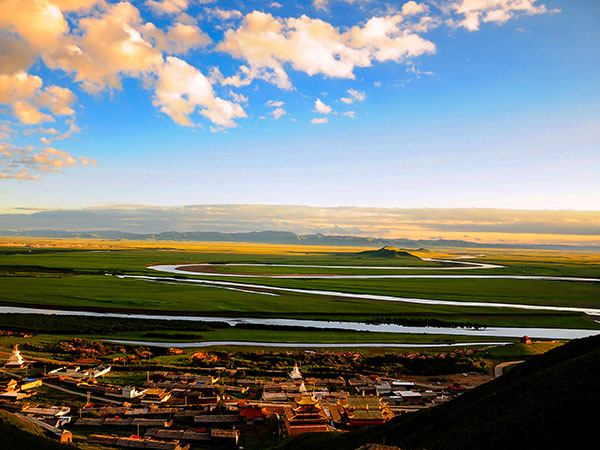
From on request